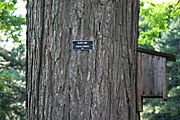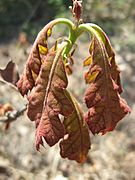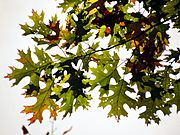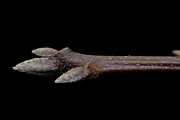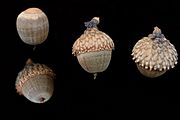Black oak facts for kids
Quick facts for kids Black oak |
|
|---|---|
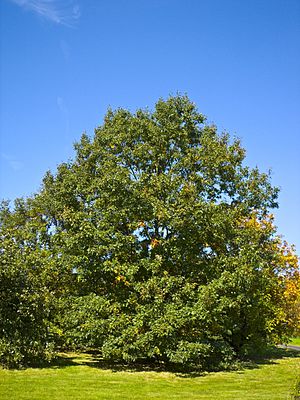 |
|
| Planted tree | |
| Conservation status | |
| Scientific classification | |
| Genus: |
Quercus
|
| Species: |
velutina
|
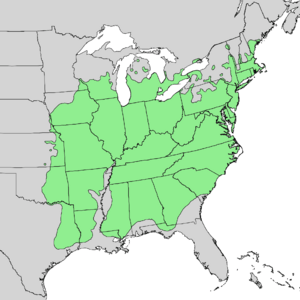 |
|
| Generalized natural range | |
| Synonyms | |
|
List
Quercus discolor Aiton
Quercus leiodermis Ashe Quercus missouriensis Ashe Quercus tinctoria Bartram Quercus tinctoria Michx. |
|
The Black Oak, known scientifically as Quercus velutina, is a common tree found across eastern and central North America. It's part of the red oak group. You can spot it from Maine all the way down to Texas, and as far west as Michigan and Minnesota. Sometimes, people call it the "eastern black oak."
This tree was once called the "yellow oak." That's because its inner bark has a yellow color. However, that name is now usually used for a different tree called the chinkapin oak. The Black Oak is also a close relative of the California black oak, which grows in western North America.
Contents
What Does a Black Oak Look Like?
Size and Height
In the northern parts of its home, the Black Oak is a medium-sized tree. It usually grows about 20 to 25 meters (65 to 80 feet) tall. Its trunk can be up to 90 centimeters (35 inches) wide. But in warmer, central areas, it can grow much taller. Some Black Oaks have been found to be as tall as 42 meters (138 feet)!
Leaves and Bark
The leaves of the Black Oak grow one after another along the branch. They are about 10 to 20 centimeters (4 to 8 inches) long. Each leaf has 5 to 7 pointed sections, like fingers. These sections are separated by deep, U-shaped dips. The top of the leaf is a shiny, dark green. The underside is a yellowish-brown and has tiny, star-shaped hairs. A good way to tell a Black Oak is by its leaves. Leaves that grow in the sun have very deep U-shaped dips. Also, the tree's buds are soft and covered in white hairs.
The inner bark of the Black Oak has a special yellow-orange color. This color comes from a natural dye called quercitron. This dye was sold in Europe for many years, up until the 1940s!
Flowers and Acorns
Black Oaks have both male and female flowers on the same tree. This is called being monoecious. The male flowers grow in long, hanging clusters called catkins. They appear in April or May, around the same time the new leaves start to grow. The female flowers are smaller and grow near the new leaves.
The tree's fruit is an acorn. These acorns grow alone or in small groups of two to five. About one-third of the acorn is covered by a scaly cap. Black Oak acorns take two years to fully grow. They turn brown when they are ready. This usually happens from late August to late October, depending on where the tree is located.
Where Black Oaks Grow Best
Black Oaks can grow in many different places. They do best in sheltered areas and on slopes that face north or east. In the southern Appalachian Mountains, you can find them as high as 1,200 meters (about 3,900 feet) up.
These trees prefer soils that drain water well. They like silty clay or loam soils. The best places for Black Oaks have good topsoil and the right kind of subsoil. Things like how much rain an area gets and how steep a slope is can also affect how well a Black Oak grows. For example, in drier western areas, Black Oaks are often found only on north and east-facing slopes where there is more moisture.
Friends of the Black Oak
Black Oaks often grow alongside many other types of trees. Some common tree friends include:
- White oak and Northern red oak
- Different kinds of hickory trees like pignut, mockernut, and shagbark
- American elm and slippery elm
- White ash
- Black walnut and butternut
- Scarlet oak and chinkapin oak
- Red maple and sugar maple
- Black cherry
- Blackgum
Smaller trees that often grow with Black Oaks include flowering dogwood, sassafras, and redbud. You might also find shrubs like mountain-laurel, witch-hazel, and different types of sumac. Common vines include greenbrier, grape, and poison-ivy.
How Black Oaks Make Seeds
Black Oaks start making seeds when they are about 20 years old. They produce the most acorns between 40 and 75 years old. These trees are good at making seeds, usually having a lot of acorns every 2 to 3 years.
However, many acorns don't get a chance to grow into new trees. Lots of animals love to eat them! Squirrels, deer, turkeys, small rodents, and birds eat a large number of acorns. In years when there aren't many acorns, almost all of them might be eaten or damaged.
Acorns from one tree usually don't travel very far on their own. Squirrels and mice help spread them a bit. But the blue jay can carry acorns much farther away, helping the Black Oak spread to new places.
Dangers to Black Oaks
Fires
Wildfires can be very harmful to Black Oaks. Fires can damage the tree's outer layers, which allows fungi to get inside. This can cause the wood to rot. Young trees are easily killed by fire. Even big trees can be killed by very strong fires. While many killed trees can sprout new growth, the damage can be a big loss.
Diseases
- Oak Wilt: This is a serious disease that can kill Black Oaks. It's found across the eastern United States. Trees can die just a few weeks after showing signs of the disease. It spreads through the roots of nearby trees and also by certain beetles.
- Root Rot: Diseases like shoestring root rot can attack Black Oaks. They often kill trees that are already weak from fire, lightning, drought, or insects.
- Foliage Diseases: These diseases affect the leaves of the Black Oak. They include things like anthracnose, leaf blister, and powdery mildews. They are similar to diseases that affect other red oak trees.
Insects
Many insects can harm Black Oaks:
- Wood-boring Insects: Some insects tunnel into the tree's trunk. These include the carpenter worm and the red oak borer. They can damage the wood, making it less useful for lumber.
- Leaf-eating Insects: The gypsy moth is a very destructive insect that eats the leaves of Black Oaks. If a tree loses its leaves two or three years in a row, it can die. Other insects that eat leaves include the variable oak leaf caterpillar and the orange striped oakworm.
- Acorn Damagers: Some insects, like nut weevils and acorn moths, damage the acorns. This means fewer new Black Oak trees can grow.
Black Oak Hybrids
Black Oaks are known for being able to mix with other types of red oaks. When two different kinds of oaks mix, they create a new kind of oak called a hybrid. There are at least a dozen different named hybrids that involve the Black Oak!
Some examples of these hybrid oaks include:
- Quercus × bushii (Blackjack oak × Black oak)
- Quercus × hawkinsiae (Northern red oak × Black oak)
- Quercus × leana (Shingle oak × Black oak)
- Quercus × vaga (Pin oak × Black oak)



